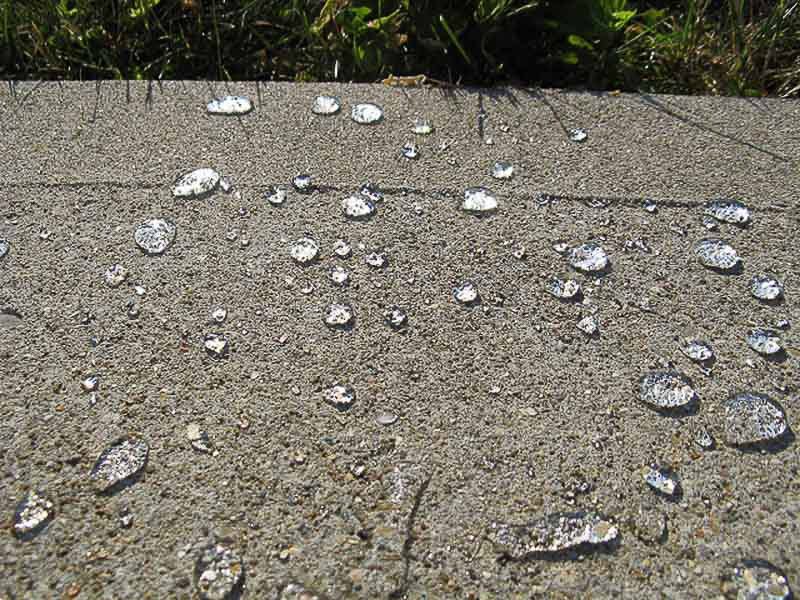Waterproofing a concrete surface
Waterproofing concrete slabs is a crucial step in extending their lifespan while preserving their natural appearance. It provides effective protection against water, oil and grease stains, as well as the damaging effects of frost and moss.
In this article, we’ll explain how to waterproof a concrete slab in three essential steps.
Step-by-step guide to waterproofing concrete
1. Clean your concrete surfaces
Before applying any waterproofing, the concrete surface must be properly prepared and cleaned.
Follow these steps:
2. Surface preparation
- Clear the slab of any furniture or clutter that might interfere with the process.
- Remove dust and debris with a broom or vacuum cleaner.
- If moss is present, treat it with an anti-moss product.
- Clean the slab thoroughly with a brush and a product such as Saint-Marc.
- Rinse the surface with clean water or a high-pressure cleaner.
- Leave the slab to dry for 2 to 3 days.
- Test the porosity of the concrete surface
For waterproofing to be effective, the concrete slab must be sufficiently porous.
You can check this with a simple test:
3. Porosity check
- Pour a little water on the concrete slab.
- If the water is absorbed in less than 3 minutes, your tiles are sufficiently porous.
- If water stagnates on the surface, forming a puddle, the slab is not porous enough. In this case, you will need to “open” the concrete by following these steps:
- Mix 1 liter of hydrochloric acid with 4 liters of water, following the manufacturer’s safety instructions.
- Pour the solution onto the slab using a watering can.
- Leave on for 1 hour, then rinse thoroughly with clean water.
- Leave to dry for 48 hours.
- Apply waterproofing to concrete
Before applying waterproofing, be sure to take the necessary precautions, as these products are volatile and potentially hazardous to health. Here’s how it works:
4. Application of waterproofing :
- Wear protective clothing, gloves, mask and goggles.
- Use a sprayer for even application.
- Fill the sprayer with waterproofing.
- Pressurize the sprayer.
- Start by spraying the waterproofing compound onto the bottom of the surface to be treated.
- Spray evenly over an area of approx. 1 m², covering all tiles and joints.
- Move on to the next surface, slightly overlapping the area already treated.
- Follow the manufacturer’s recommendations for drying times.
- Apply a second coat of waterproofing after initial drying.
- Wait 24 hours before putting your garden furniture back in place and enjoying your waterproofed terrace.
By following these steps, you can effectively waterproof your concrete slabs, extending their lifespan and protecting them from the elements.

Concrete and its impermeability
Conventional concrete is not 100% waterproof. Water resistance depends on drying and curing. Fresh concrete is more sensitive to water than hardened concrete.
The use of waterproof cements is an option, but polishing and sealing concrete is often the best solution.
Use of waterproof cements
Waterproof cements can improve the water resistance of concrete, but they do not make it completely waterproof. The concrete surface remains porous, which can encourage the growth of harmful micro-organisms. For effective waterproofing, concrete should be polished and sealed.
Concrete sealing
To make concrete more water-resistant, we recommend polishing and sealing it with special products. Discover our concrete cleaning services
These products penetrate deep into the material, hardening the structure and providing a better seal. They also make cleaning easier and prevent the formation of moss, lichen and algae.
Trust the experts for your work
While some homeowners consider carrying out the project themselves, calling in a professional guarantees uniform application and minimizes the risk of costly mistakes. Trust Prostationnement for your renovations.
Concrete waterproofing classes
Concrete can be classified into different categories according to its density and compressive strength. The four main classes are :
- Class 1: completely dry (suitable for living areas, archives, etc.).
- Class 2: dry or slightly damp (for storage of moisture-sensitive products, cellars, etc.).
- Class 3: damp (used for buildings with lesser use, such as underground parking lots).
- Class 4: damp or wet (used for shelter structures).
Weak points in waterproofing
After construction, weak points may appear, such as holes for fixing shelves or other elements. These areas must be hermetically sealed to prevent moisture and infiltration.
Horizontal moisture protection
Horizontal waterproofing is essential to prevent moisture penetrating from the ground. It consists of a liquid seal applied to the wall, forming an impermeable barrier.
Conclusion
In conclusion, waterproofing concrete is essential to extend its life and preserve its appearance.
Follow these steps and consider your sealing options to ensure effective protection of your concrete slabs against water, oil and other damaging elements.
For best results, we recommend that you call on the services of professionals experienced in concrete waterproofing.






